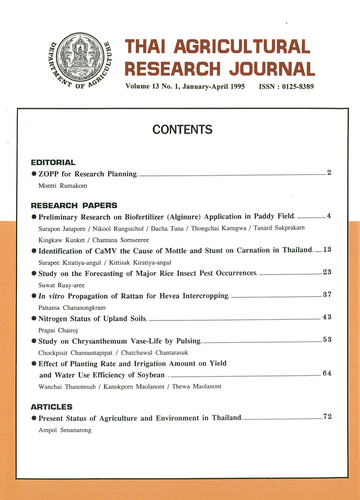In vitro Propagation of Rattan for Hevea Intercropping
DOI:
https://doi.org/10.14456/thaidoa-agres.1995.4Keywords:
rattan, in vitro propagationAbstract
Rattan in one of the prominent crops that adds to the growth of the national crops that adds to the growth of the national economics. Thailand is earning considerable income form exporting rattan in the form of furniture and handicrafts each year. Most of rattan used is obtained from the forest which is gradually reducing. Rattan grows well in humid condition. The shade under the nature rubber plantation is forming about the same level of humidity suitable for rattan. It has been observed that rattan can prosper well under such condition. Rattan will therefore be a supplement crops with good return to the rubber holders. The propagation of rattan can be done only through the seeds which are scarcely found in the natural forest. Therefore, other possible method of propagation is beign studied by using tissue culture technique. Songkhla Rubber Research Centre is experimenting on the use of shooting tip of Traka-Thong seedling by slicing them into pieces of about 1 mm thickness. Every piece is cut through its tip, then cultured on basal medium (Enjalric et al. 1982) with 2 g/litre activated charcola and 60 g/litre sugar. the plant growth regulators (PGR) N -Benzyladenine (BA), 3-Indolebutyric acid (IBA) and 2,4-Dichlorophenoxy acetic acid (2-4-D) are added and preparing in 7 different combiantions. It was found that the medium contains 25 mg/litre BA and 10 mg/litre IBA gives the best result i.e. with the highest number of strong and healthy plantlets. they can transplanted into soil 4 months after culturing.
Downloads
Published
How to Cite
Issue
Section
License

This work is licensed under a Creative Commons Attribution-NonCommercial-NoDerivatives 4.0 International License.
Thai Agricultural Research Journal



